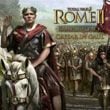Army | General tips
There are not as many types of troops available in Rome II: Caesar in Gaul as in the base game, however, you can still distinguish four fundamental categories: infantry, cavalry, ranged units, and siege engines. Since the gameplay in the add-on is much more dynamic and combat-focused, it is necessary to have a well balanced, well trained, and well equipped army.

You are not offered a wide selection of units at the very beginning. The only available ones are: several types of infantry and one or two ranged units. Your very first conquests will be spearheaded by these troops, so use them to their limit. General's bodyguard unit in a newly created army should be made of cavalry - this way you gain a unit of heavy armoured horse riders, which may prove crucial for the few next battles. You also need infantry. I recommend to choose the units with highest morale, so they were able to keep the enemies busy long enough for your cavalry to strike from the back. As far as ranged units are concerned, there is not much to choose from: you can either recruit skirmishers or slingers. I recommend the latter, because initially skirmishers have little ammunition and thus are not able to have an influence on the result of an entire battle. Only after unlocking proper improvements, can you buy 2-3 skirmishers units, who will then be able to force an enemy to break the line.

After you manage to conquer a couple of provinces and build basic military buildings (see: Province development: army), you can start creating specialized armies. For starters, I recommend having two offensive armies: infantry- and cavalry-focused. The first one consists of: a general with infantry bodyguards, several elite assault units, which form the army's core, and common troops with high morale - the last have to be able to tie the enemy in fighting until the reinforcement arrives. The infantry-focused army should contain several ranged units, which would weaken the enemy before the decisive clash. If possible, I recommend using archers for this - they have an average range, deal large damage, and their ammunition supply should be enough to break 2-3 enemy units.
The other army should consist of cavalry only. The general should be accompanied by elite raiders, while the core of the army should be formed by the heaviest cavalry available at the time. Initially, this army's size may be just 1/3 of the infantry-focused army, in future though, you should expand it so the cavalry and the infantry were in 1:1 ratio.

After some time you will need a third army, equipped with siege engines. This one should consist of an infantry general unit, several common infantry units (1/4 of the army size) and ranged units (1/4). The remaining 50% of the army should consist of war machines: I recommend using onagers and ballistas - scorpios' effectiveness is too low, so they may be useful only at the beginning.
When cooperating, the three aforementioned armies can conquer any city in Gaul, and when skillfully commanded, they can defeat any troops combination an opponent may put forward. Sadly, there is rarely an opportunity to expand your army slowly - it is often necessary to raise one in just a couple of turns. In such cases, I recommend to recruit a mix of close quarter infantry and of cavalry in 2:1 ratio, and fill up the rest with mercenaries.
Mercenaries

These troops serve as temporary reinforcements to your base army. You should hire them just before a battle starts and dismiss as soon as the fight is over. Recruiting mercenaries is quite cheap, but their board is very expensive - this is why they should never be the core of your army. Mercenaries are excellent for striking at lone infantry armies. Whenever you notice an enemy army in forced march mode in the midst of your territory, you may use mercenaries to deliver a devastating blow to the enemy or even annihilate his troops. To do this, just recruit a new general with cavalry bodyguards (horse riders are much more effective against the infantry whom you are going to attack) and fill the rest of the army with mercenaries. Upon striking at the enemy, you will play a special type of battle: an ambush. This way you can easily defeat all the enemy troops, while minimizing your own losses. Ambush will be further described in one of the following chapters.
You are not permitted to copy any image, text or info from this page. This site is not associated with and/or endorsed by the SEGA or Creative Assembly. All logos and images are copyrighted by their respective owners.
Copyright © 2000 - 2025 Webedia Polska SA for gamepressure.com, unofficial game guides, walkthroughs, secrets, game tips, maps & strategies for top games.
